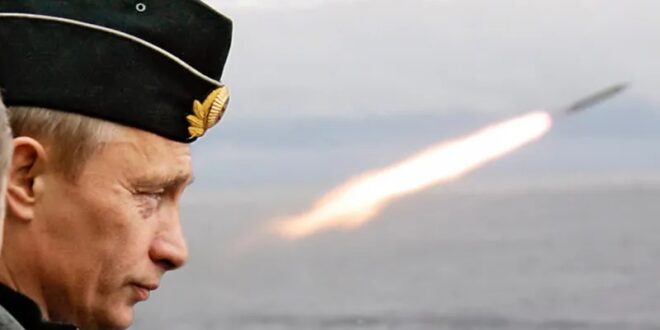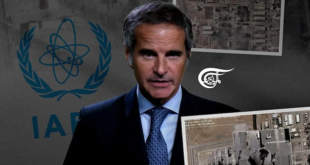With Russia Going Rogue, America Must Cooperate With China
Just days into Russia’s invasion of Ukraine, Dmitri Medvedev, the former president and prime minister of Russia, took to social media to post a chilling message. He raged against Western sanctions on his country and suggested darkly that Russia could rip up some of its most important agreements with the West. He mentioned the New START treaty, the nuclear arms reduction agreement signed with the United States over a decade ago, but the threat was broader still: the sundering of all diplomatic ties with Western countries. “It’s time to hang huge padlocks on the embassies,” he wrote.
Now that Russian President Vladimir Putin has taken steps to mobilize his nuclear forces—and made more likely the once remote possibility that nuclear weapons might be used in modern conflict—Medvedev’s post presages a dangerous turn. Furious at the response to its war in Ukraine, Russia might cut itself off from everything that it has accomplished in controlling and limiting nuclear weapons. Since the Cuban Missile Crisis in 1962, the Soviet Union and then Russia have played a generally positive role in preventing nuclear proliferation, halting nuclear testing, and reducing nuclear stockpiles. Even as Russian tanks have been rolling through Ukraine, experienced Russian negotiators in Vienna have been working with the United States and other partners to resuscitate the Iran nuclear deal.
Russia has been a giant of the nonproliferation regime. The major treaties of the twentieth century all benefitted from the skills of Russian negotiators and the wisdom of Russian experts. The Nuclear Nonproliferation Treaty, also known as the NPT, a momentous agreement that has curbed the spread of nuclear weapons for over half a century, was the product of joint problem solving by Soviet and American diplomats at a time when the two superpowers were facing off over the Middle East and Vietnam. Tensions were so high that the United States raised the nuclear alert level in 1967 after jittery U.S. military commanders detected a mysterious disruption to their surveillance radars (caused, it turned out, not by Soviet machinations but by a solar flare). Somehow, no matter how bad the crisis, the two countries continued talking to keep nuclear weapons under control and prevent their spread.
The invasion of Ukraine may end this admirable tradition. Russia could become more isolated and cease to play any responsible international role, as Medvedev’s threat to leave the New START treaty and shutter the embassies in Moscow suggests. Alternatively, Moscow could remain broadly at odds with its Western rivals but pick some arenas, such as nuclear nonproliferation, where it sees mutual advantage in meeting at the negotiating table. The United States, for its part, should do what it can to keep Russia engaged and constructive in arms control diplomacy. But Washington has good reason to be wary of Moscow’s increasingly rogue behavior and it should consider turning to another rival, Beijing, in seeking to prop up the nonproliferation regime. The costs of Putin’s invasion of Ukraine continue to mount, but the United States should act to limit wider damage to the architecture of international security.
ARMS CONTROL REGIME CHANGE
Russian isolation in the wake of the invasion of Ukraine will jeopardize further progress on nuclear nonproliferation. A conference to review the NPT, repeatedly postponed due to the COVID-19 pandemic, is now tentatively scheduled to take place this August. Normally, Russia would join the four other nuclear weapons states recognized by the NPT—China, France, the United Kingdom, and the United States—to push forward on disarmament goals. Just this January, these countries jointly reiterated a statement issued by Ronald Reagan and Mikhail Gorbachev in 1985 that a nuclear war cannot be won and must never be fought, a symbolic act intended to bolster the NPT regime.
A productive review conference in August seems absurd, now that Putin has threatened to use nuclear weapons to deter others from joining in his fight with Ukraine. This posturing may be purely strategic, a form of saber-rattling designed to signal Russian strength and determination. But it has made the unthinkable a little more thinkable. If Putin decides to use even one nuclear weapon, the world will enter territory untrodden since the U.S. bombings of Hiroshima and Nagasaki in 1945.
Russia, one can only hope, will not go down this path, instead walking back from the nuclear brink and again committing to diplomacy around nonproliferation. It will be a slow climb-back, however. The first order of business will be to rebuild confidence among negotiators. The current generation of negotiators from the five major nuclear states know one another and understand the nonproliferation regime, so this task should not be impossible. Next, the NPT member states should closely examine the current disarmament and nonproliferation superstructure, built around the NPT, to see whether it should be strengthened. This review should also extend to the organization and operating procedures of the International Atomic Energy Agency, an institution charged with the mission of promoting and safeguarding the peaceful use of nuclear technology.
Putin has made the unthinkable use of nuclear weapons a little more thinkable.
The states invested in preserving the NPT face considerable pressure from nonnuclear countries that back the Treaty on the Prohibition of Nuclear Weapons, which entered into force in January 2021 and which seeks full disarmament and the prohibition of nuclear weapons. The signatories of this treaty are unhappy with the progress achieved in the NPT regime and are likely to push for tougher measures to expedite disarmament, such as economic sanctions against any state continuing to deploy nuclear weapons. With Russia issuing nuclear threats—and worse, potentially using a nuclear weapon—state and corporate actors may respond more willingly to such pressures. The NPT states, including the nuclear weapon states, are going to have to find ways to build common objectives with the Ban Treaty community.
It will also take time to renew confidence in bilateral negotiations between Russia and the United States, but it is possible. Negotiators from both countries know each other and have been working steadily on maintaining strategic stability—the incentives that prevent the first use of nuclear weapons—and on the renewal of the Iran nuclear deal. Washington and Moscow should begin by restoring constraints on intermediate-range ground-launched missiles, also known as INF missiles, in Europe. Both sides agree broadly on this issue—at least, they did before the present crisis. Russia was willing to remove from Europe missiles that violated the INF treaty and move them east of the Ural Mountains, with a verification regime to monitor their deployment. For its part, the United States was willing to consider foregoing the deployment of INF missiles in Europe. Adopting these measures would help lay the groundwork for broader U.S.-Russian cooperation on maintaining and strengthening the arms control regime.
Russia and the United States will have a harder time coming to an agreement about replacing the New START treaty, currently in force but set to expire in 2026. Before the current crisis, the two sides were far apart in what they wanted to see in the next round of talks. The United States wanted constraints on Russian nonstrategic nuclear warheads and new exotic systems, such as nuclear-propelled naval weapons, while the Russians wanted constraints on U.S. precision strike conventional missiles and missile defenses. Despite these differences, negotiators were inching toward mutual understanding, outlining what each side believed was essential in any new treaty—until Russian soldiers rolled into Ukraine. These dynamics must cause the United States to think long and hard about what it can achieve with Russia at the nuclear negotiating table. As always, the U.S. national security interest must be paramount. If negotiations serve the national interest in countering the fundamental threat that nuclear weapons pose, then the United States should be ready to talk.
Putin looms over these considerations and puts in doubt any kind of meaningful cooperation. He seems bent on cutting Russia off from the outside world and plunging the country further into autarky. If he remains in office, the return of Russia to any negotiating table will be hard, never mind talks about nuclear weapons. Russia could be turning into a very big nuclear pariah state, which the United States must deter not only with military force but also with sound policy and the strength of its ideas. The entire international community will come to depend on the United States. Putin may try to widen his circle of admirers beyond Cuba, Nicaragua, and Venezuela, but in the main, the world will not be turning to Russia as a trusted player.
A BIGGER SEAT FOR CHINA
With Russia at best a less reliable partner, China’s role in the international arms control regime will become increasingly vital. China has hidden behind Russia and the United States for many years, arguing that their much larger strategic nuclear arsenals require them to take the lead in nuclear nonproliferation and disarmament discussions. China’s own arsenal is now growing and Beijing seems inclined, at least in the context of the NPT regime, to play some leadership role. Tellingly, China also seems willing to facilitate a cease-fire in the current war in Ukraine.
If Russia absents itself from nuclear diplomacy, the United States and China will have to consider how they, budding superpower rivals, can develop a greater partnership to resolve problems in the global arms control regimes. Of course, U.S. and Russian nuclear arsenals are a lot larger than the Chinese one, and China’s ongoing modernization and military buildup will not change that fact any time soon. The primary purpose of cooperation between the United States and China in the immediate period should be to work together closely to shore up the NPT regime, ensuring that the upcoming review conference does not fail and working with the other NPT countries to strengthen the regime. The two countries should also work to preserve other arms control mechanisms such as the Organization for the Prohibition of Chemical Weapons, which implements the global ban on chemical weapons, and the Comprehensive Nuclear Test Ban Treaty Organization, which monitors the moratorium on nuclear testing and prepares for the entry into force of the Comprehensive Nuclear Test Ban. In both cases, China and the United States can do much to further new verification procedures and expedite decision-making within the organizations. Without these concerted efforts, Russia may begin to play a wrecking role, preventing new ideas from moving forward and obstructing the work of negotiators and policymakers. China and the United States might also consider working to constrain weapons systems where they have relatively equal capabilities, such as in INF missiles and direct ascent antisatellite weapons.
If China and the United States can demonstrate successful cooperation in these areas, it will help other powers breathe more easily and feel reassured that the world is not heading into a free-for-all of weapons of mass destruction. The crisis in Ukraine can be the shock that boots the global community into redoubling its efforts to constrain such weapons. If states do not seize this chance, they risk ushering in a new, terrifying arms race.
 Eurasia Press & News
Eurasia Press & News




